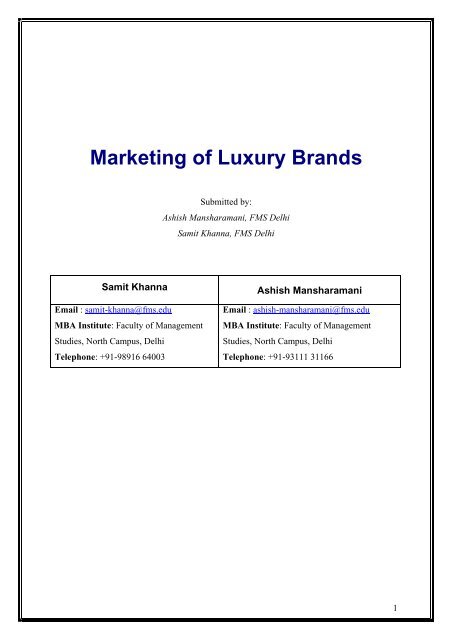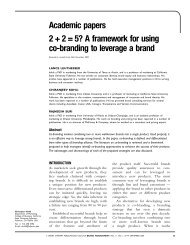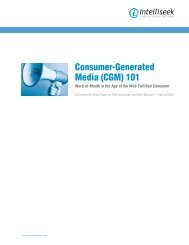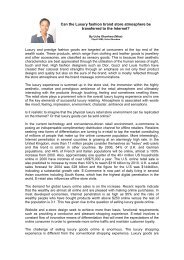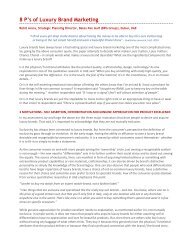Marketing Of Luxury Brands - Brandchannel
Marketing Of Luxury Brands - Brandchannel
Marketing Of Luxury Brands - Brandchannel
You also want an ePaper? Increase the reach of your titles
YUMPU automatically turns print PDFs into web optimized ePapers that Google loves.
<strong>Marketing</strong> of <strong>Luxury</strong> <strong>Brands</strong><br />
Submitted by:<br />
Ashish Mansharamani, FMS Delhi<br />
Samit Khanna, FMS Delhi<br />
Samit Khanna Ashish Mansharamani<br />
Email : samit-khanna@fms.edu<br />
MBA Institute: Faculty of Management<br />
Studies, North Campus, Delhi<br />
Telephone: +91-98916 64003<br />
Email : ashish-mansharamani@fms.edu<br />
MBA Institute: Faculty of Management<br />
Studies, North Campus, Delhi<br />
Telephone: +91-93111 31166<br />
1
EXECUTIVE SUMMARY<br />
<strong>Luxury</strong> branding is a whole new ball-game altogether, both from the perspective of<br />
the marketer as well as the luxury consumer. It therefore becomes important to<br />
view it both in relation and isolation from the ‘regular’ goods marketing.<br />
To achieve the above objective, we first look at how luxury goods are different<br />
from regular goods and then go on to explore some facets and trends of the luxury<br />
goods as well as their market and consumers. This finally sums up into a SWOT<br />
analysis of the luxury goods segment, thereby helping in obtaining a bird’s eye<br />
view of the exercise at hand.<br />
Considering that the luxury concept has shifted to the ‘new’ meaning, we delve<br />
into that aspect to understand the drivers for luxury brands presently, as well in<br />
the time to come. This is followed by a luxury potential determination of the<br />
Indian market both in terms of quantitative growth factors as well as qualitative<br />
initiatives.<br />
Post identification of the mindset of the Indian luxury consumer, we have<br />
conducted a synergetic strategy building exercise, in an attempt to make sure that<br />
there are actionable points, which will go on to ensure the best interplay between<br />
the 3 most important factors for a luxury brand, i.e. the product brand, the brand<br />
/ reputation of the service provider and the price-value relationship of the luxury<br />
brand.<br />
2
TABLE OF CONTENTS<br />
Getting to know luxury......................................................................1<br />
Difference between regular & luxury goods ....................................2<br />
Characteristics of the luxury industry .............................................3<br />
<strong>Luxury</strong> in India ..................................................................................6<br />
Strategies for <strong>Luxury</strong> <strong>Marketing</strong> in India .......................................7<br />
Conclusion.........................................................................................12<br />
References .........................................................................................13<br />
3
Getting to know luxury<br />
“Why do I need to know how the watch market is doing? I’m in the business of<br />
luxury”, Partick Heiniger, CEO, Rolex<br />
<strong>Luxury</strong> brands have often been associated with the core competences of creativity,<br />
exclusivity, craftsmanship, precision, high quality, innovation and premium<br />
pricing. These product attributes give the consumers the satisfaction of not only<br />
owning expensive items but the extra-added psychological benefits like esteem,<br />
prestige and a sense of a high status that reminds them and others that they<br />
belong to an exclusive group of only a select few, who can afford these pricey<br />
items.<br />
The luxury sector targets its products and services at consumers on the top-end of<br />
the wealth spectrum. These self-selected elite are more or less price insensitive<br />
and choose to spend their time and money on objects that are plainly opulence<br />
rather than necessities. For these reasons, luxury and prestige brands have for<br />
centuries commanded an unwavering and often illogical customer loyalty.<br />
<strong>Luxury</strong> has never been something easy to define, yet this mystery concept is<br />
something highly desired by one and all alike. We look at delving deeper into this<br />
mystery and aura of luxury goods by way of comparing them against ‘regular<br />
goods’ as well as highlighting the characteristics of the luxury industry. But before<br />
beginning with that, lets first attempt to understand some common terms<br />
associated in the world of high-end goods :<br />
<strong>Luxury</strong> and prestige brands such as Rolex, Louis Vuitton and Cartier represent the<br />
highest form of craftsmanship and command a staunch consumer loyalty that is not<br />
affected by trends. These brands create and set the seasonal trends and are also<br />
capable to pulling all of their consumers with them wherever they go.<br />
Premium brands are those brands like Polo Ralph Lauren, Calvin Klein and Tommy<br />
Hilfiger that aspire to be luxury and prestige brands but their marketing mix<br />
strategies are more attuned to a mass market, albeit a luxury mass market. They<br />
are also termed as mass-premium brands or mass-luxury brands.<br />
Fashion brands on the other hand are those that address the masses.<br />
1
Difference between regular & luxury goods<br />
2
Characteristics of the luxury industry<br />
1. <strong>Luxury</strong> means different things to different people<br />
<strong>Luxury</strong> has no certified origins. But luxury branding is said to have taken<br />
birth in the west with the appearance of high-end brands. To get an insight<br />
into what luxury today means to different Americans, we take a look at the<br />
table below, compiled by American Demographics in 2003, to understand<br />
how to develop target strategies for various segments.<br />
2. <strong>Luxury</strong> is a product category in itself<br />
This can be best explained by the fact that both an expensive watch and an<br />
artwork can be considered to be luxury items. Therefore, all luxury<br />
marketers are not just competing in their ‘technically defined’ product<br />
categories (like manufacturers of refrigerators compete amongst<br />
themselves) but for the wallet share of luxury goods in total.<br />
3. The meaning of luxury had changed<br />
<strong>Luxury</strong> has moved from its ‘old’ meaning of ownership (also known as<br />
conspicuous consumption - Conspicuous consumption is a term used to<br />
describe the lavish spending on goods and services that are acquired mainly<br />
for the purpose of displaying income or wealth rather than to satisfy a real<br />
need of the consumer. In the mind of a conspicuous consumer, such display<br />
serves as a means of attaining or maintaining social status. Invidious<br />
consumption, a necessary corollary, is the term applied to consumption of<br />
goods and services for the deliberate purpose of inspiring envy in others) of<br />
objects to the ‘new’ meaning of the experience / fulfilment derived from<br />
possessing a certain object.<br />
3
4. Aura is more important than exclusivity<br />
Exclusivity is something that cannot be ensured to a great extent and<br />
neither is it the prime requirement of a luxury consumer. The consumer<br />
bases his decisions on the relevance of the aura of the brand to his<br />
fulfilment or actualization needs.<br />
5. Classification of luxury consumers<br />
SRI Consulting Business Intelligence places consumers in 3 groups<br />
according to what luxury means to them :<br />
<strong>Luxury</strong> is Functional – these consumers tend to buy luxury<br />
products for their superior functionality and quality. Consumers in<br />
this segment, the largest of the three, tend to be older and<br />
wealthier and are willing to spend more money to buy things that<br />
will last and have enduring value. They buy a wide array of luxury<br />
goods, from artwork to vacations, and conduct extensive prepurchase<br />
research, making logical decisions rather than emotional<br />
or impulsive. Messages that highlight product quality and are<br />
information-intensive are powerful with this group.<br />
<strong>Luxury</strong> is Reward – these consumers tend to be younger than the<br />
first group but older than the third. They use luxury goods as a<br />
status symbol to say “I’ve made it!” They are motivated by their<br />
desire to be successful and demonstrate this to others. <strong>Luxury</strong><br />
brands that have widespread recognition are popular, however<br />
they don’t wish to appear lavish or hedonistic in their appearance.<br />
They want to purchase “smart” luxury that demonstrates<br />
importance while not leaving them open to criticism. <strong>Marketing</strong><br />
messages that communicate acceptable exclusivity resonate with<br />
this group.<br />
<strong>Luxury</strong> is Indulgence – this group is the smallest of the three and<br />
tends to include younger consumers and slightly more males than<br />
the other two groups. Their purpose for luxury goods is to lavish<br />
themselves in self-indulgence. They are willing to pay a premium<br />
for goods that express their individuality and make others take<br />
notice and are not overly concerned with product longevity or<br />
possible criticism. They enjoy luxury for the way it makes them<br />
feel, therefore have a more emotional approach to purchases.<br />
4
6. Trading up<br />
They respond well to messages that highlight the unique and<br />
emotional qualities of a product.<br />
A mass of wealthy people have emerged the world over, give rise to a large<br />
section of consumers who are now moving to luxury / premium brands,<br />
thereby creating greater business opportunity for luxury marketers.<br />
7. Emergence of luxury brands<br />
Sea of luxury brands have emerged giving a wide choice to consumers, in all<br />
segments of luxury goods.<br />
8. Trading down<br />
Today, fashion brands are giving luxury brands competition because of<br />
marketing mix and branding strategies, which make it acceptable to pair<br />
these two brands. This is something that was not practiced before.<br />
eg. Wearing an Armani shirt with a pair of GAP jeans<br />
9. Factors at play<br />
In luxury marketing there is a subtle interplay between three factors that<br />
most strongly influence the luxury consumer to buy: product brand; dealer<br />
or store’s brand or service providers’ reputation; and price/value<br />
relationship<br />
10. Customer loyalty is more important that brand awareness<br />
Rather than focus on measuring the brand awareness of a luxury company,<br />
measuring customer loyalty is far more significant a metric regarding the<br />
success or failure of corporate strategy to connect with the luxury<br />
consumer.<br />
5
<strong>Luxury</strong> in India<br />
To be successful in India, it is both necessary to gauge the financial potential as<br />
well as the mindset of the Indian luxury consumer. This will help in bringing forth<br />
the right product offerings to the Indian consumer as well as targeting them<br />
better.<br />
Qualitative Insights<br />
1. According to a study by American Express, ‘Inside the Affluent Space’, the<br />
mindset of the Indian consumer is a desire to prove that “I’ve Made It”. This<br />
can be related to the luxury categorization which is based on the fact that<br />
luxury is seen as a reward, both for achievements in life as well as<br />
showcasing these achievements to others.<br />
2. The <strong>Luxury</strong> <strong>Marketing</strong> Council Worldwide has established a chapter in India,<br />
with the aim of promoting luxury in India. Their task will also be to build<br />
synergy between various luxury brands interested in India by way of sharing<br />
of consumer insights as well as best practices.<br />
3. Even the Asian region is not uniform in its preference for luxury in terms of<br />
need fulfilment. Therefore, it becomes important to delineate the needs of<br />
the Indian consumer from the other Asian regions to target them better.<br />
This agenda gains importance because many Indians look at acquiring luxury<br />
from places such as Hong Kong, Tokya, China etc.<br />
Eg. It is interesting to note that Singapore consumers are more of<br />
connoisseurs compared to Hong Kong consumers who want Talk-Value from<br />
their luxury goods<br />
4. Hindustan Times has been at the forefront of driving the luxury revolution in<br />
India by organizing two Indian <strong>Luxury</strong> Conferences in the last 4 years. To<br />
add to it, it also brings out a monthly supplement of luxury goods available<br />
in India, thereby creating awareness for the luxury brands.<br />
Quantitative Insights<br />
1. As far as quantitative estimates are concerned, there will be 135,000<br />
millionaires (in US dollar terms) in India by 2009.<br />
2. The affluent market is set to grow at a rate of 13% in India, and by 2009,<br />
there will be approximately 1.1 million affluents here.<br />
3. The wealth potential of India’s affluents was to the tune of US$ 203 billion<br />
as of 2005.<br />
6
Strategies for <strong>Luxury</strong> <strong>Marketing</strong> in India<br />
There are conventional foundations for ensuring success of a brand and they are<br />
listed below in brief :<br />
1. The brand must be “expansive”<br />
Which means it should be full of innovation opportunities for the marketer<br />
and in terms of satisfying the divergent needs of the luxury consumer<br />
2. The brand must tell a story<br />
It is this story, of either heritage or performance or other aspects that goes<br />
on to build the aura of a brand over time. The story always accentuates the<br />
identity of the brand.<br />
3. The brand must be relevant to the consumers’ needs<br />
Depending upon the mindset of the luxury class, it is imperative for a brand<br />
to satisfy those needs, whether they be for recognition or functional use<br />
etc.<br />
4. The brand must align with consumers’ values<br />
A brand that does not concur with the basic values of a consumer’s society<br />
has a small chance of succeeding because luxury items are forms of<br />
expression or identification for a luxury consumer. This makes it difficult<br />
for the consumer to adopt the brand in such cases.<br />
5. The brand must perform<br />
Irrespective of which category the brand belongs to, a performance<br />
assurance is a must for the brand if it wishes to be in the evoked set of<br />
luxury consumers, considering the price being paid for luxury.<br />
7
Based on the inputs given above as well as an understanding of the decision making<br />
process of the luxury consumer, we recommend the following paths for luxury<br />
marketers based on what Indian consumers really desire from their luxury brands,<br />
i.e. product brand, dealer/store brand and price/value relationship :<br />
(The price / value relationship has been accorded less focus since the Indian<br />
consumer is at a phase when cost of luxury is secondary to its appeal / benefits)<br />
1. Brand Me Affluent!<br />
It is turning out to be a raging battle for the luxury marketers in terms of<br />
customer loyalty. The customer will switch to whichever brand that<br />
accentuates his affluence.<br />
TASK : It is essential for marketers to ensure that the recognition value<br />
of their brands is always high so that it lends a sense of affluence to the<br />
consumer, which can only come if others around him / her perceive the<br />
brand to be a top-notch luxury brand. This can come from either being<br />
aligned with the most successful celebrities or being a part of elite<br />
events and promotions.<br />
There are also some luxury branding strategies available to the luxury<br />
marketer which can be used since the consumer is obsessed with the<br />
ownership of a luxury brand but may not have enough financial strength<br />
of acquire some of the luxuries.<br />
<strong>Luxury</strong> brand strategies<br />
8
Having a separate line of goods available at lower cost<br />
eg. refurbished cars and line extensions<br />
Promoting luxuries as a wise investment<br />
eg. Villas<br />
“Targeted luxury” is yet another concept increasingly being<br />
used by luxury brands where luxury product memorabilia is<br />
given to the relevant target segment in an attempt to fuel<br />
their desire for owning the product.<br />
eg. Miniature models of Mercedes cars, key chains of<br />
Rolex watches<br />
Additionally, it is also important to estimate the amount of efforts<br />
required for building brand loyalty, which can be considered inversely<br />
proportional to the brand loyalty in a category. An indication of the same<br />
is given in the table below :<br />
9
2. Nothing but the Best! – Because I’m the best<br />
Given the wealth escalation in the coming years, the Indian consumers<br />
are ready to empty their wallets in an attempt to go beyond satisficing<br />
their needs. They want the best, be it in whichever category because it<br />
helps them relate to the feeling of being the best in their fields, thus<br />
completing their sense of accomplishment.<br />
TASK : This is a golden opportunity for the marketer to earn greater<br />
margins by adding customized value to his line of luxury goods. These<br />
added-value customized goods will ensure that the customer feels he has<br />
something more than just the ordinary range of luxury goods available.<br />
3. <strong>Luxury</strong> is having the world at my fingertips – First!<br />
The “I’ve Made It” desire can only be achieved if a consumer has access<br />
to the luxury products before anyone else. If someone else gains access<br />
to those luxury goods, then that particular good becomes a me-too<br />
product.<br />
TASK : A luxury marketer will not only have to be faster than his<br />
competitors in reaching out to the consumer, to gain a share of wallet<br />
but also continuously offer innovative products that serve to<br />
differentiate between the consumers.<br />
4. “Ethnic Chic” – The Fusion of Local & Global goods<br />
The Indian consumer, while attempting to ape the West, also sees a sign<br />
of luxury in the Indian culture / royalty. Taking this point forward, a<br />
consumer also attempts to build a connect with his roots while at the<br />
same time making efforts to achieve grandeur.<br />
TASK : This point is connected to the strategy of a product being in line<br />
with the consumers’ values for it to be adopted. Apart from this, in the<br />
Indian context, ethnicity is also a fashion statement in many product<br />
categories such as<br />
5. You Think I’m Demanding? Next!<br />
The quantitative figures do foresee a large population of luxury<br />
consumers. As it happens in most cases where the segment size increases<br />
substantially, products move towards standardization and service levels<br />
become low to achieve economies of scale. However, it is important to<br />
understand that the luxury market does not behave in this manner at all.<br />
10
TASK : The marketer’s job should be a constant endeavour to offer<br />
newer luxury goods to the consumer, in sync with their needs. In<br />
addition to that, marketers will need to make sure that each and every<br />
single consumer has to be treated with a high-level of personalized<br />
attention, given the nature of the product and the consumer. Even minor<br />
shortfalls in this case will have the consumer shifting their brand<br />
preferences to those marketers who can satisfy their needs better.<br />
6. CANNIBALIZATION OF BRANDS<br />
Recent trends indicate that many celebrities, which are more like the<br />
mainstay than the ambassadors of various brands, are launching their<br />
own brands. In situations like these, luxury marketers are affected since<br />
they have lesser number of celebrities to associate their brands, as well<br />
as increased competition.<br />
TASK : It thus becomes essential to ensure that successful celebrities are<br />
partnered with at the right time, thereby both eliminating chances of<br />
competition as well as delivering the right aspirational / appeal message<br />
to the intended audience.<br />
11
Conclusion<br />
The starting point for identifying successful luxury brand strategies in India has<br />
been established by identifying certain salient aspects of luxury brands that remain<br />
constant as well as identifying the stage of mindset of the Indian consumer<br />
towards these brands.<br />
The focus is now towards ‘how soon’ luxury brands will enter the market to gain a<br />
first mover advantage, which is of significant importance in India. Apart from how<br />
soon, we primarily focus on ‘how will’ luxury brands cater to the mainly<br />
aspirational needs of the Indian consumer.<br />
A word of caution that goes for luxury marketers, irrespective of their brands and<br />
geographical presence – The luxury consumer is always looking for newer ways to<br />
satisfy his continuously changing needs. Hence, the need to keep a close tab<br />
through insightful research is of prime importance.<br />
As far as India is concerned, given the rapidly accelerating affluence of the<br />
masses, the scenario is set to witness a boom. The ones who will be riding the<br />
wave will be the ones who’ve kept their ears open to each and every word of their<br />
each and every customer. After all, in the luxury business, no marketer can afford<br />
the luxury of treating its consumers as a loosely bunched segment.<br />
12
References<br />
Articles<br />
1. Eight Things That Every Marketer Needs to Know about the New <strong>Luxury</strong><br />
Market; Pam Danziger<br />
2. The Changing Face of <strong>Luxury</strong>; Patricia Graham and Marcus Matthews<br />
3. The Psychology of Travel – What is <strong>Luxury</strong>?; STAR Group<br />
4. How to Build a ‘New <strong>Luxury</strong>’ Brand; Unity <strong>Marketing</strong><br />
5. The Unmistakable sign language of luxury; Hindu Business Line<br />
6. What Becomes a <strong>Luxury</strong> Brand Most?; Chief Marketer.com<br />
Books<br />
1. Let Them Eat Cake: <strong>Marketing</strong> <strong>Luxury</strong> to the Masses — as well as the Classes;<br />
Pam Danziger<br />
2. THE CULT OF THE LUXURY BRAND; Radha Chadha and Paul Husband<br />
Websites<br />
1. unitymarketing.com<br />
2. hindustantimes.com<br />
3. brandchannel.com<br />
4. britishluxurycouncil.com<br />
5. wikipedia.com<br />
6. brandnoise.com<br />
Secondary Research<br />
1. Inside the Affluent Space; American Express study by Peter Raj Kapoor<br />
2. What people perceive as luxury; American Demographics 2003<br />
13


